#14 rue Royale
Explore tagged Tumblr posts
Text

Les Modes : revue mensuelle illustrée des arts décoratifs appliqués à la femme, no. 94, vol. 8, octobre 1908, Paris. Robe d'après-midi, par Caroline, 14 rue Royale. Photo Chéri-Rousseau & Glauth. Bibliothèque nationale de France
#Les Modes#20th century#1900s#1908#periodical#fashion#fashion plate#photograph#bibliothèque nationale de france#dress#Modèles de chez#Maison Caroline#Chéri-Rousseau & Glauth#one color plates
95 notes
·
View notes
Text
Les Mis Canon-era Paris Photographs: Jean Valjean and Cosette’s route to escape Javert, in Pictures!

Jean Valjean's escape through Paris is Victor Hugo's way of mourning the Paris he knew from before his exile, the Paris before the modern renovations.
Hugo wrote Les Mis from exile in Guernsey, at the same time as Paris was undergoing a series of massive renovations. The "Old City" of medieval Paris that Hugo loved was being replaced by the “New City" of Baron Haussman. The dark medieval labyrinth lit by oil lamps was being replaced by modern wide streets and standardized architecture lit by gas lamps. Victor Hugo is nostalgic for the Paris he remembers before his exile-- so Jean Valjean is able to escape Javert using things unique to the Old City. He escapes through a labyrinth of tiny medieval streets in a neighborhood Hugo claims was destroyed during the renovations; he climbs over the convent wall using the rope from an oil lamp, the very oil lamps that were being replaced by the more modern gas lanterns. The dark maze hides him from police surveillance in a way modern streets cannot.
A man named Charles Marville photographed Paris shortly before many (though not all) of the renovations occurred. In this post I'll go through all the different streets mentioned in the Valjean-Javert Paris chase chapters, and provide Marville's photographs whenever they the image has been labeled with the name of the street. Note that there may be some inaccuracies. Some street names changed over time.
Here is a map of what the chase looks like, taken from the book "Paris in the Times of Victor Hugo."
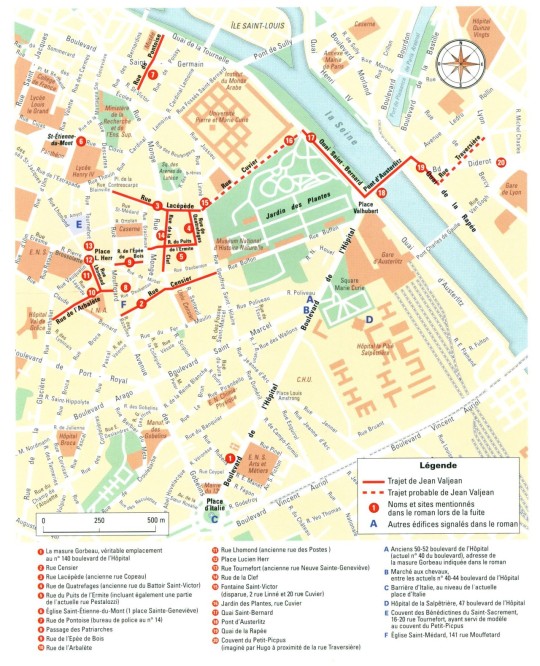
A quick overview: Jean Valjean starts in a slummy half-built suburban area. This area is highly associated with the King; the royal Jardin des Plantes is nearby, and King Louis XVIII often rides by in his carriage during the afternoons. After travelling down a bunch of streets, "zigzagging" back and forth, Jean Valjean decides to cross the Seine over the Bridge of Austerlitz (a bridge named after one of Napoleon's victories.) Then he reaches the areas of the city near the Faubourg Saint Antoine that are more associated with working class rebellion. From there he enters a dark isolated half-built medieval neighborhood near marshes and timberyards, with narrow mazey alleyways, that Hugo mostly made up. Hugo pretends this medieval neighborhood used to exist, but was destroyed like many others during the recent renovations. Now that we've gotten the overview out of the way, let's go more specific!
The chase starts out in "the old quarter of the Marche aux Chevaux." At the time, this was a less inhabited and poorer area of Paris; it's described as basically a slum. Here are some of Marville's photographs :

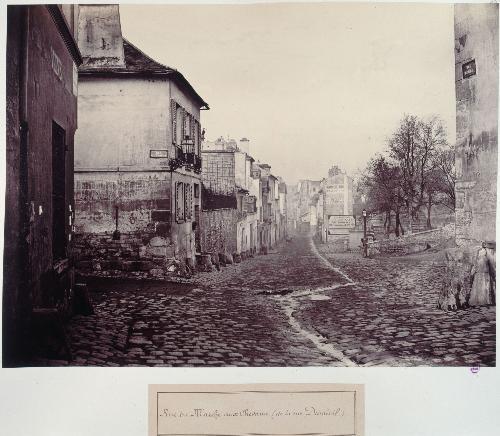
Then we're told "Jean Valjean described many and varied labyrinths in the Mouffetard quarter, which was already asleep, as though the discipline of the Middle Ages and the yoke of the curfew still existed. He combined in various manners, with cunning strategy, the Rue Censier:"
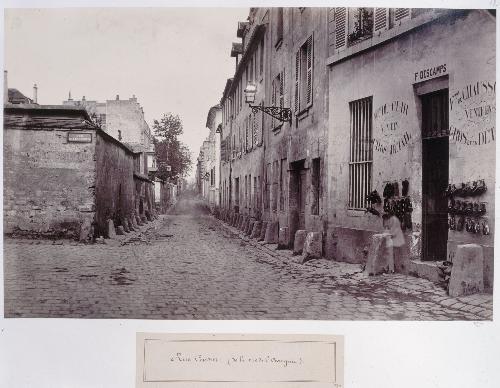
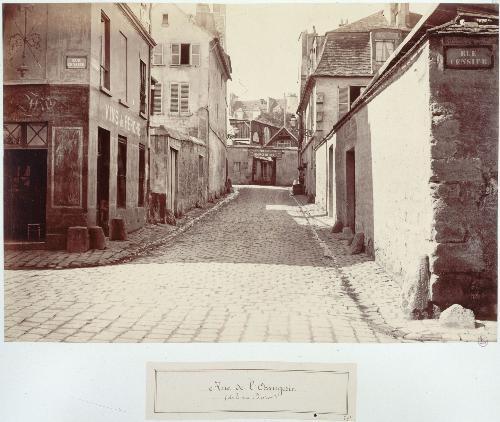


"and the Rue Copeau," (according to the map I linked earlier, the Rue Copeau is now the Rue Lacepede. Here is Marville's pic:)

"the Rue du Battoir-Saint-Victor and the Rue du Puits l’Ermite. There are lodging houses in this locality, but he did not even enter one, finding nothing which suited him. He had no doubt that if any one had chanced to be upon his track, they would have lost it."
"As eleven o’clock struck from Saint-Étienne-du-Mont:" (note: this refers to the church of Saint-Etienne)

"he was traversing the Rue de Pontoise, in front of the office of the commissary of police, situated at No. 14." (Jean Valjean sees Javert and the police following him on this street, because they're visible in the light of the lantern from the police station.)
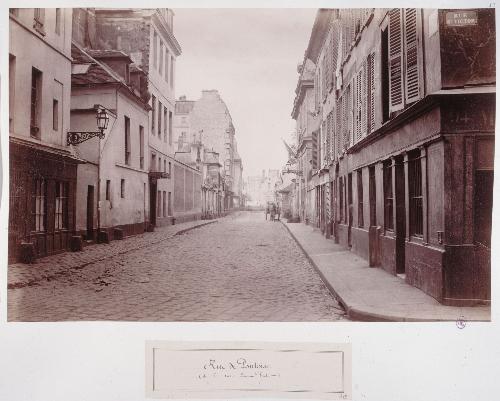
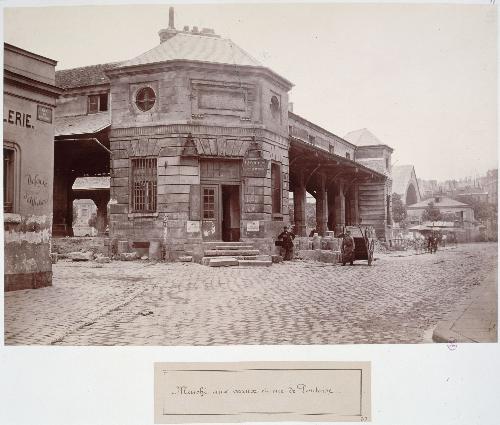
"He took a circuit, turned into the Passage des Patriarches, which was closed on account of the hour,"
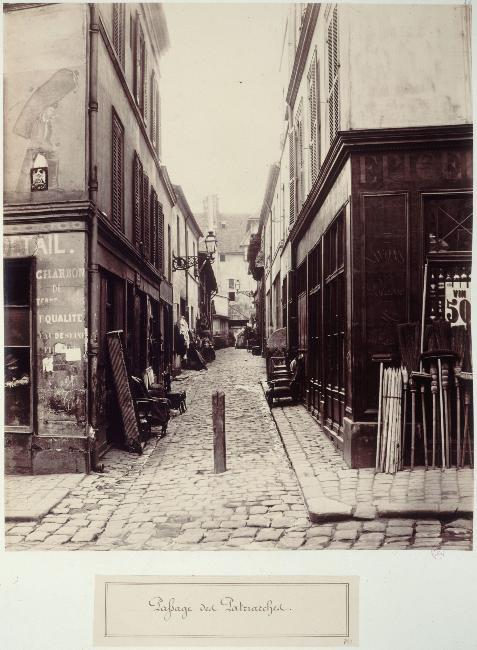
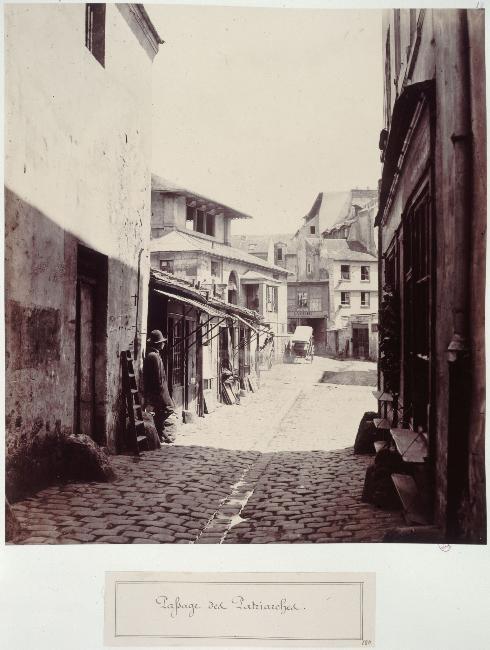
"strode along the Rue de l’Épée-de-Bois

and the Rue de l’Arbalète, and plunged into the Rue des Postes."



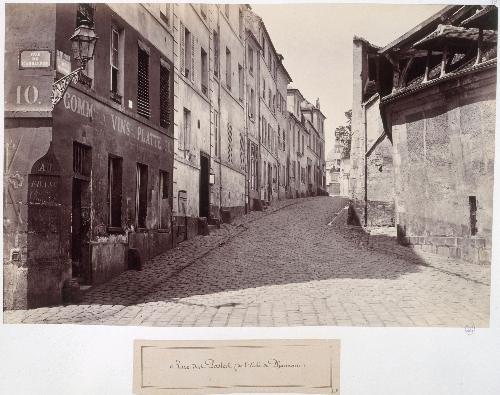
"At that time there was a square formed by the intersection of streets, where the College Rollin stands to-day, and where the Rue Neuve-Sainte-Geneviève turns off." (Note: these streets are labeled Montagne-Sainte-Geneviève, but not Neuve-Sainte-Geneviève, so they may be different streets! But I'm putting them here anyway.)
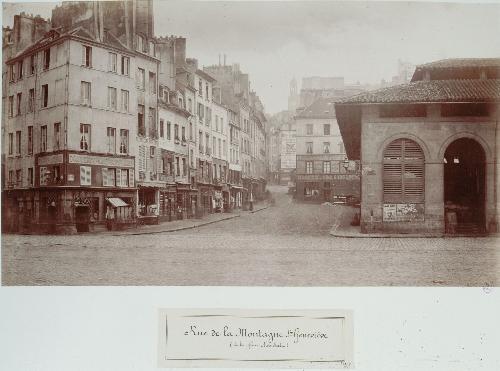
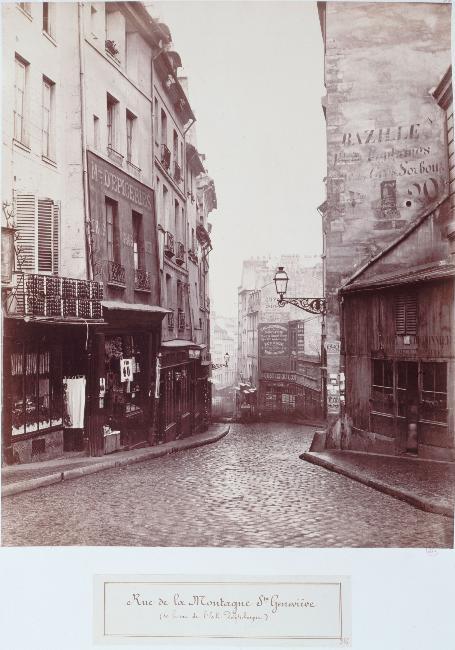

"It is understood, of course, that the Rue Neuve-Sainte-Geneviève is an old street, and that a posting-chaise does not pass through the Rue des Postes once in ten years. In the thirteenth century this Rue des Postes was inhabited by potters, and its real name is Rue des Pots." (Annotation: Hugo's bein silly and making little puns. He's snarkily pointing out the "new saint-genevieve street" is old, and the post street rarely has post-chaises/carriages go through it.) (Jean Valjean hides in the shadows and watches to see who shows up in this big square intersection of streets. In the moonlight, he recognizes Javert.) "He slipped from under the gate where he had concealed himself, and went down the Rue des Postes (which I shared a picture of previously), towards the region of the Jardin des Plantes." (Note: the Jardin des Plantes is a royal garden. Here is a modern photo from Wikipedia.)

"He left behind him the Rue de la Clef,

"then the Fountain Saint-Victor, skirted the Jardin des Plantes by the lower streets, and reached the quay. There he turned round. The quay was deserted. The streets were deserted. There was no one behind him. He drew a long breath.
He gained the Pont d��Austerlitz." (The Pont d'Austerlitz, named after Napoleon's victory at the battle of Austerlitz, is a very famous bridge. Marville has no photographs but here's an 1830 engraving:)

"The bridge once crossed, he perceived some timber-yards on his right. He directed his course thither. In order to reach them, it was necessary to risk himself in a tolerably large unsheltered and illuminated space. He did not hesitate. Those who were on his track had evidently lost the scent, and Jean Valjean believed himself to be out of danger. Hunted, yes; followed, no." Here's the quai by the pont-au-change-- a different quai, but gives you an idea of what the areas around the Seine often looked like.
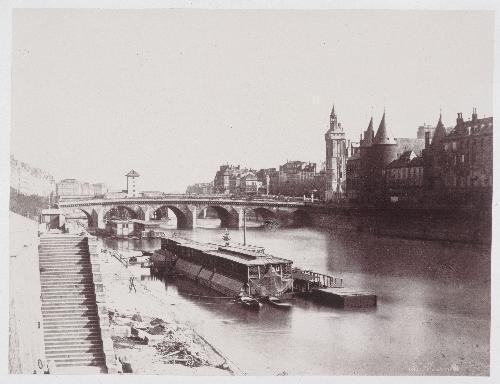
(Then Jean Valjean sees Javert and the other police on the Bridge of Austerlitz, following him. He hurries towards the darker alleys of the city.)
"A little street, the Rue du Chemin-Vert-Saint-Antoine, opened out between two timber-yards enclosed in walls. This street was dark and narrow and seemed made expressly for him."
Here's an abandoned timber-yard-ish looking picture:

But Marville has no photographs of this street. I'd have to double check, but iirc this is the part where Hugo starts to 'make up' more street layouts. I wouldn't be surprised if this street really WAS made expressly for him (meaning Hugo made it up.) "The point of Paris where Jean Valjean found himself, situated between the Faubourg Saint-Antoine and la Râpée, is one of those which recent improvements have transformed from top to bottom,—resulting in disfigurement according to some, and in a transfiguration according to others. The market-gardens, the timber-yards, and the old buildings have been effaced. To-day, there are brand-new, wide streets, arenas, circuses, hippodromes, railway stations, and a prison, Mazas, there; progress, as the reader sees, with its antidote."
(Here Hugo talks about the Haussman renovations directly, claiming that if his street layouts are "inaccurate" it's because these are some of the Old Medieval Streets that were razed during Paris's recent renovations. He goes on for a while comparing Petit-Picpus to various other areas that were changed during the renovations.)
"Le Petit-Picpus, which, moreover, hardly ever had any existence, and never was more than the outline of a quarter, had nearly the monkish aspect of a Spanish town. The roads were not much paved; the streets were not much built up. (....) Such was this quarter in the last century. The Revolution snubbed it soundly. The republican government demolished and cut through it. Rubbish shoots were established there. Thirty years ago, this quarter was disappearing under the erasing process of new buildings. To-day, it has been utterly blotted out."
The Petit-Picpus, of which no existing plan has preserved a trace, is indicated with sufficient clearness in the plan of 1727, published at Paris by Denis Thierry, Rue Saint-Jacques, opposite the Rue du Plâtre;

and at Lyons, by Jean Girin, Rue Mercière, at the sign of Prudence.
Petit-Picpus had, as we have just mentioned, a Y of streets, formed by the Rue du Chemin-Vert-Saint-Antoine, which spread out in two branches, taking on the left the name of Little Picpus Street, and on the right the name of the Rue Polonceau. The two limbs of the Y were connected at the apex as by a bar; this bar was called Rue Droit-Mur.
The Rue Polonceau ended there; Rue Petit-Picpus passed on, and ascended towards the Lenoir market. A person coming from the Seine reached the extremity of the Rue Polonceau, and had on his right the Rue Droit-Mur, turning abruptly at a right angle, in front of him the wall of that street, and on his right a truncated prolongation of the Rue Droit-Mur, which had no issue and was called the Cul-de-Sac Genrot." Here is @everyonewasabird's attempt to puzzle this out:

It was here that Jean Valjean stood."
Then Jean Valjean escapes by pulling down an old oil lantern, strung up by ropes. Hugo notes that this would have been "impossible if the streets were lit with gas, the way they would be after the renovations. This picture shows an old oil lamp strung up by ropes:

Finally, Jean Valjean climbs over the wall into the Petit-Picpus convent. This convent is fictional. Hugo pretends it used to exists but is no longer around-- another relic of the early 19th century that has been lost over time.
TLDR:
Jean Valjean's escape through Paris is Hugo way of mourning the Paris he knew from before his exile, the Paris before the modern renovations. To quote Volume 2 Book 5 Chapter 1:
The author of this book, who regrets the necessity of mentioning himself, has been absent from Paris for many years. Paris has been transformed since he quitted it. A new city has arisen, which is, after a fashion, unknown to him. There is no need for him to say that he loves Paris: Paris is his mind’s natal city. In consequence of demolitions and reconstructions, the Paris of his youth, that Paris which he bore away religiously in his memory, is now a Paris of days gone by. He must be permitted to speak of that Paris as though it still existed. It is possible that when the author conducts his readers to a spot and says, “In such a street there stands such and such a house,” neither street nor house will any longer exist in that locality. Readers may verify the facts if they care to take the trouble. For his own part, he is unacquainted with the new Paris, and he writes with the old Paris before his eyes in an illusion which is precious to him. It is a delight to him to dream that there still lingers behind him something of that which he beheld when he was in his own country, and that all has not vanished. So long as you go and come in your native land, you imagine that those streets are a matter of indifference to you; that those windows, those roofs, and those doors are nothing to you; that those walls are strangers to you; that those trees are merely the first encountered haphazard; that those houses, which you do not enter, are useless to you; that the pavements which you tread are merely stones. Later on, when you are no longer there, you perceive that the streets are dear to you; that you miss those roofs, those doors; and that those walls are necessary to you, those trees are well beloved by you; that you entered those houses which you never entered, every day, and that you have left a part of your heart, of your blood, of your soul, in those pavements. All those places which you no longer behold, which you may never behold again, perchance, and whose memory you have cherished, take on a melancholy charm, recur to your mind with the melancholy of an apparition, make the holy land visible to you, and are, so to speak, the very form of France, and you love them; and you call them up as they are, as they were, and you persist in this, and you will submit to no change: for you are attached to the figure of your fatherland as to the face of your mother.
184 notes
·
View notes
Text

thanks to @weather-mood, we discovered Interview With the Vampire Season 2 Soundtrack which is yet to be released! The tracklist contains major spoilers so beware! The tracklist details and short samples for free listening is at the end of this post
Imagine Never Being Able To Dream
2. She Could Dream, Thank You
(Synchron Stage Orchestra, Bernhard Melbye Voss)
3. The Whole World Was Ready To Return
(Synchron Stage Orchestra, Bernhard Melbye Voss)
4. Paris Sucks
(Daniel Hart, Evan Smith, Synchron Stage Orchestra, Bernhard Melbye Voss)
5. Who Are The Young Men
(Daniel Hart, Evan Smith, Marc Osterer, Synchron Stage Orchestra, Bernhard Melbye Voss)
6. Armand For You
(Synchron Stage Orchestra, Bernhard Melbye Voss)
7. Raglan James
(Daniel Hart, Damir Orascanin, Synchron Stage Orchestra, Bernhard Melbye Voss)
8. The Fourth Great Law
(Synchron Stage Orchestra, Bernhard Melbye Voss)
9. A Vein Winding Through The Heart Of Paris
(Daniel Hart, Veronika Vitazkova, Anna Frisanova, Synchron Stage Orchestra, Bernhard Melbye Voss)
10. I Don't Like Windows When They're Closed
(Daniel Hart, Alina Cherone, Synchron Stage Orchestra, Bernhard Melbye Voss)
11. Amadeo
(Daniel Hart, Eleanor Tinlin)
12. Madeleine
(Shruti Kumar, Synchron Stage Orchestra, Bernhard Melbye Voss)
13. Abducted
(Synchron Stage Orchestra, Bernhard Melbye Voss)
14. Take As Many With Me As I Could
(Daniel Hart, Bobak Lotfipour, Synchron Stage Orchestra, Bernhard Melbye Voss)
15. Hello Francis, Goodbye Francis
(Daniel Hart, Evan Smith, Synchron Stage Orchestra, Bernhard Melbye Voss)
16. First Time In New Orleans
(Shruti Kumar, Synchron Stage Orchestra, Bernhard Melbye Voss
17. I Didn't Know It Was A Gift
(Synchron Stage Orchestra, Bernhard Melbye Voss)
18. Ladies And Gentlemen
(Daniel Hart, Bobak Lotfipour, Hideaki Aomori)
19. Jardin De Satan
(Daniel Hart, Hideaki Aomori)
20. Come To Me Again
(Daniel Hart, Sam Reid)
21. Annika
(Daniel Hart, Iosua Dascal, Damir Orascanin, Synchron Stage Orchestra, Bernhard Melbye Voss)
22. Le Bucheron
(Daniel Hart, Damir Orascanin, Synchron Stage Orchestra, Bernhard Melbye Voss)
23. Flirty Salesman Shuffle
(Daniel Hart, Bobak Lotfipour, Evan Smith)
24. Woodcutter
25. The Five Great Laws
26. Baby Lu
(Synchron Stage Orchestra, Bernhard Melbye Voss)
27. Je N'Aime Pas Fenêtres Quand Fermée
(Daniel Hart, Alina Cherone)
28. For A Young Violinist Again
29. Love Wronged
30. In Nomine Magni
31. Followed Closely By My Madness
(Synchron Stage Orchestra, Bernhard Melbye Voss)
32. Vien À Moi Encore
(Synchron Stage Orchestra, Bernhard Melbye Voss)
33. Come To Me On Rue Royale
Soundtrack details and samples: https://www.prestomusic.com/classical/products/9625720--interview-with-the-vampire-season-2-original-television-series-soundtrack
188 notes
·
View notes
Text
Chopin’s Wardrobe — What I Wore
Today I would like to share with you all the manner in which I dressed. It is interesting to see how fashions have changed over the course of 200 years. Some might say style has slipped… Anyway! Here are some details on my wardrobe:
My Suit
I liked to wear sober colours: black, mauve, blue… and especially grey. For instance, I once asked Julian Fontana to have made for me a pair of dark grey winter trousers, without a belt, which were smooth and stretchy.

Grey trousers, 1840.
At a concert in Glasgow, a pupil recalled that I had worn a pale grey suit. Which included a frock-coat of identical tint and texture.


(Left) Frock coat, 1840. (Right) Frock coat and trousers, 1852.
Under my suit, I would wear a modest waistcoat in a fabric such as a black velvet with a tiny inconspicuous pattern, something very quiet and elegant.



(Left) Provençal waistcoat with mauve silk seedlings, 1860. (Centre) Waistcoat with floral pattern, 1838. (Right) Striped waistcoat, 1850-70.
My preferred shirts were ones made of cambric or batiste fabric. They had small mother-of-pearl buttons, two breast-pockets, and could be bought for 14 francs.

For my cravat, I would wear muted colours during the day. Usually, I would tie it in a bow. However, when performing in a formal setting, I would wear a broad, white silk cravat.


Winter Clothes
To keep warm in the winter months, I wore a thick redingote or over-frock coat, as can be seen in this daguerreotype of myself from 1849.




(Left) Wool coat, 1840. (Centre) Winter costume. Paul Gavarni, 1846. (Right) Frock coat. Wool, trimmed with silk velvet. 1820-1830.
At one point, my sickness rendered me so sensitive to the cold that I wore three flannels under my trousers.

Underpants, mid-nineteenth century.
Accessories
Because I had small feet, I often found shoes uncomfortable. I mourned the day, Moos, my shoemaker died. No one made my shoes like him.

1840s men’s shoes.
On my head, I would always have my hair curled, and, when outdoors, I would wear a top hat. I bought my hats from Dupont’s because he made them lightweight. They were originally made of beaver felt but, by my later life, they were made of silk plush.


(Left) Top hat made of beaver felt, 1830s. (Right) Top hat made of silk plush, 1850.
My outfit was only complete with white gloves. Without them one would not be in good taste. Kid gloves were common, but I also liked wearing Swedish (suede) gloves. Always in white.

Evening gloves. 1848.
A pocket handkerchief was also a necessity.

Finally, I had a miniature pocket watch. According to one concert-goer, it was “In shape no bigger than an agate stone, on the forefinger of an alderman.”

Where did I shop?
I bought my top hats from Dupont’s at No 8, rue de Montblanc (the previous name for rue de la Chaussée-d’Antin). I lived on this street myself, both at No 5 (1833-36) and No 38 (1836-38).


(Left) 9, rue de la Chaussée-d’Antin, the fabric shop across the street from the milliners, 1840s. (Right) Rue de la Chaussée-d’Antin, 1858-1878.
My shirts came from No 37 in the Palais Royal galleries, on the theatre side.


(Left) View of the Galerie d'Orléans in the Palais-Royal, 1838. (Right) Jardin du Palais Royal, 1840s.
The white suede gloves could be acquired from À la Corbeille de Fleurs, Houbigant’s shop at No 19, rue du Faubourg Saint-Honoré.


(Left) The corner of rue du Faubourg-Saint-Honoré, 1820-1840. (Right) Faubourg Saint-Honoré, 1814-1885.
There were also many shops along the Grands Boulevards. This is where I got my trousers made by my tailor, Dautremont.


(Left) Boulevard de la Madeleine, 1799. (Right) Boulevard des Capucines, 1830.


Boulevard des Italiens, 1840s (left), 1835 (right).
So…
As you can see, in spite my reputation for being picky and perhaps… prissy, with regard to fashion and furniture, I was far from what was called a dandy. My dress was never over-the-top and nor did I put on the airs that were so pertinent to dandyism. My desire, if anything, was to be refined and respectable. Although, perhaps my efforts to do so were occasionally cause for frenzy or distraction.
#1830s#1840s#historical men's fashion#romantic era#frycek’s fashion tips#biography#frédéric chopin#fashion history
124 notes
·
View notes
Text










🍁 Romantic little things you must do in Quebec: 1, Come to Quebec in autumn to see the maple leaves once, see the layers of forests and the colourful leaves in superb colours! 2、Explore the Fairmont Chateau Fontana Hotel, which is one of the most famous attractions in Quebec.
Take a stroll through Little Champlain, one of the oldest commercial districts, with many art galleries, restaurants and more!
Don't miss the 17th century staircase in Petit Champlain, the oldest staircase in Quebec City.
The National Gallery of Quebec, one of the city's top museums. 6.Eat and drink at the Old Port Market, which is located in the historic harbour district and is filled with food stalls. 7.Visit the Capital Observatory for a stunning view of Quebec City, located on the 31st floor of the Marie-Guyart Building, the tallest building in the city.
Visit Place Royale, underneath the old Quebec cable car, and check out the giant mural. 9: Take a walk on the Dufferin Terrace, a wooden walkway around the Château de la Fontaine with plenty of benches for relaxing. 10、Cathedral of Notre Dame de Quebec, one of the oldest cathedrals in North America. 11、Wander around Old Quebec, hiking is the best way to travel around the city. 12, Walk along Rue Saint-Jean for shopping and coffee, it's really super cosy! 13.Sample the local cuisine, such as cheese fries with gravy or Tortier cheese. 14, Stay at a great [❤️Airbnb] B&B in Quebec!
90 notes
·
View notes
Text
Frev Friendships — Robespierre and Couthon

…Moreover, don’t forget to remind me of the memory of Lacoste and Couthon. Robespierre in a letter to Maurice Duplay, October 16 1791, while away on a leave in Arras.Couthon, Lacoste and Pétion are the only of his friends that he mentions in the letter. Considering Couthon came to Paris after being elected for the Legislative Assembly on September 9 1791, while Robespierre was away from the capital between October 14 and November 28, the two must have befriended each other quite rapidly. In a letter dated September 29 1791, Couthon reveals that he has moved into the house of one M. Girot on Rue Saint-Honoré (the same street where Robespierre lodged), and according to Robespierre (1935) by J.M Thompson, the Almanach royal for 1792 gives Couthon’s address as 343 Rue Saint-Honoré. So the proximity between their lodgings might have been a contributing factor.
My friend, I anxiously await news of your (votre) health. Here, we are closing in on the greatest events. Yesterday the Assembly absolved La Fayette; the indignant people pursued some deputies at the end of the session. Today is the day indicated by a decree for the discussion of the forfeiture of Louis XVI. It is believed that this matter will be further delayed by some incident. However, the fermentation is at its height, and everything seems to presage for this very night the greatest commotion in Paris. We have arrived at the outcome of the constitutional drama. The Revolution will take a faster course, if it does not sink into military and dictatorial despotism. In the situation we are in, it is impossible for the friends of liberty to foresee and direct events. The destiny of France seems to leave it to intrigue and chance. What can reassure us is the strength of the public spirit in Paris and in many departments, it is the justice of our cause. The sections of Paris show an energy and wisdom worthy of serving as models for the rest of the state. We miss you. May you soon return to your homeland and we await with equal impatience your return and your recovery. Robespierre in a letter to Couthon, August 9 1792 (incorrectly dated July 20 1792 in the correspondence)
I saw [Couthon] towards the last days of the Legislative Assembly; he appeared to me to be in a mood similar to mine; enemy of the anarchists and of the authors of the massacres of the first days of September, enemy of Marat and Robespierre; he constantly declaimed against them. Supplément aux crimes des anciens comités de gouvernement, avec l'histoire des conspirations du 10 mars, des 31 mai et 2 juin 1793, et de celles qui les ont précédées, et tableau de la conduite politique d'un représentant du peuple mis hors la loi (1794) by Jacques-Antoine Dulaure.
Couthon, whose infirmities give a new value to his patriotism… […] Lettres de Maximilien Robespierre à ses commettans, number 1 (September-October 1792)
During the first three months of the session of the National Convention, the members of the Puy-de-Dome deputation fraternized and dined together once a week. Couthon then never ceased to pour out invectives against Robespierre. Once I told him that I thought Robespierre an intriguer. ”So you call him an intriguer,” he answered me with vivacity, ”You are too nice, I regard him as a great scroundel.” I heard him, in the presence of several of my colleagues, one day when the deputation was summoned to his house, say: ”I no longer want to live in the same house as Robespierre, I am not safe there; every day we see a dozen cutthroats coming up to his house to whom he gives dinner. I do not know how he managed to meet these expenses before being elected to the Convention, while my allowances are barely enough for me to live with my family.” He often applauded the fact that the entire deputation professed the same principles, and that, consequently, we would always be united in heart and mind. This was Couthon's opinion at the time, and he held to it until the constitutional committee was formed. He had the ambition to be a member; he becomes furious at not being inclined to it. This was the time when Couthon changed his opinion, abandoned his conscience to indulge in his passions. Supplément aux crimes des anciens comités de gouvernement, avec l'histoire des conspirations du 10 mars, des 31 mai et 2 juin 1793, et de celles qui les ont précédées, et tableau de la conduite politique d'un représentant du peuple mis hors la loi (1794) by Jacques-Antoine Dulaure. Dulaure’s claim that Couthon for a time lived in the same house as Robespierre is confirmed by l’Almanach national, an II (cited in Paris révolutionnaire: Vieilles maisons, vieux papiers (1906) by Georges Lênotre) as well as by a letter dated October 4 1792 Couthon wrote to Roland from Rue Saint-Honoré n. 366 (Robespierre’s address) asking for rooms in the Tuileries, saying that he must move out of the house within eight days (Roland responded with a negative answer four days later). When exactly he moved in is however harder to pinpoint. According to Robespierre (1935) by J.M Thompson, the Almanach royal for 1792 still gives Couthon’s address as 343, not 366, rue St. Honoré, and in the article The Evolution of a Terrorist: Georges Auguste Couthon (1930) Geoffrey Bruun writes that Couthon moved to Cour de Manège 97 in 1792. It can therefore be concluded that Couthon’s stay on Rue Saint-Honoré n. 366 was most likely rather short. Couthon’s motivation for moving out, aside from Dulaure’s claim that he disliked Robespierre, could also be related to the fact Robespierre’s brother and sister moved in with the Duplays shortly after he wrote the letter to Roland.
The Lamenths and Pétion in the early days, quite rarely Legendre, Merlin de Thionville and Fouché, often Taschereau, Desmoulins and Teault, always Lebas, Saint-Just, David, Couthon and Buonarotti. The elderly Élisabeth Le Bas on visitors to the Duplays during the revolution
Robespierre notes this expression: “for fear that Couthon’s speech will not be heard.” Couthon will be heard, he said, and I maintain that the representative assembly has no right to stifle his voice any more than that of anyone else, because the Convention is not a power above the rights of its constituents who have invested every deputy with the sacred right to express their wish, and one could only obstruct this by an attack against liberty, and by trampling on national sovereignty. Robespierre takes this opportunity to recall the maneuvers of a large party of the Convention, to violate this sacred right that each member has to make his voice heard; and we see, he says, this game of intrigue played out every day with incredible modesty. In the Constituent and Legislative Assemblies, which despite their perversity, at least knew how to respect the freedom of opinions, Couthon's patriotism, which his infirmities make more interesting, never served the most perverse men as a pretext to stifle his voice. Robespierre therefore invites us to come out strongly against this new system of villainy, and to never allow a deputy to ever be deprived of the ability to express his opinion. He ends by supporting the impression of Couthon's speech; it is put to the vote and adopted. Robespierre makes sure the Jacobins print one of Couthon’s speeches regarding the trial of the king, after protests that they ought to wait until it’s been pronounced at the Convention as well, January 6 1793
If you want, and it would be a crime to doubt it, to preserve the liberty, unity and indivisibility of the Republic, you cannot hesitate to adopt Couthon's proposal [to issue a proclamation that the Insurrection of May 31 saved liberty] at once. To begin a discussion on this question would be to allow the conspirators to come to this rostrum to make new declarations against Paris, with their ordinary perfidy. Robespierre at the Convention June 13 1793
The proposal [to have Robespierre enter the Committee of Public Safety] was made to the committee by Couthon and Saint-Just. To ask was to obtain, for a refusal would have been a sort of accusation, and it was necessary to avoid any split during that winter which was inaugurated in such a sinister manner. The committee agreed to his admission, and Robespierre was proposed. Memoirs Of Bertrand Barère (1896) volume 2, page 96-97. Couthon was elected to the Committee of Public Safety on June 10 1793, Robespierre on July 27 1793. In his memoirs, Barère pushes the thermidorian idea that the two plus Saint-Just formed a ”triumvirate” within the committee. On page 146 of the same volume he nevertheless also writes that Robespierre and Saint-Just rarely came to the committee, instead working together in a private office.
Robespierre, Saint-Just and Couthon were inseparable. The first two had a dark and duplicitous character; they pushed away with a kind of disdainful pride any familiarity or affectionate relationship with their colleagues. The third, a legless man with a pale appearance, affected good-nature, but was no less perfidious than the other two. All three of them had a cold heart, without pity, they interacted only with each other, holding mysterious meetings outside, having a large number of protégés and agents, impenetrable in their designs. Révélations sur le Comité de salut public (1830) by Prieur-Duvernois. Later in the revelations, Prieur nevertheless also writes that ”Couthon was never difficult on the Committee; there was no altercation until the day before 9 Thermidor, when the moment to throw away the mask had arrived.”
The National Convention, citizens colleagues, witnessed with pleasure your entry into Lyon. But its joy could not be complete when it saw that you at the first movements yielded to a sensibility way too unpolitical. You seemed to abandon themselves to a people who flatter the victors, and the manner in which you speak of such a large number of traitors, of the punishment of a very few and the departure of almost all, have alarmed the patriots who are indignant at seeing so many scoundrels escaping through a gap and going to Lozère and mainly Toulon. We therefore won’t congratulate you on your successes before you have fulfilled all that you owe to your country. Republics are demanding; there is national recognition only for those who fully deserve it. We send you the decree that the Convention issued this morning on the report of the Committee. It has proportioned the vigor of its measures to your first reports. It will never remain below what the Republic and liberty expect. Beware above all of the perfidious policy of the Muscadins and the hypocritical Federalists, who raise the standard of the Republic when it is ready to punish them, and who continue to conspire against it when the danger has passed. It was that of the Bordelais, of the Marseillais, of all the counter-revolutionaries of the South. This is the most dangerous stumbling block of our freedom. The first duty of the representatives of the people is to discover it and avoid it. We must unmask the traitors and strike them without pity. These principles alone, adopted by the National Convention, can save the country. These principals are also yours; follow them; listen only to your own energy, and carry out with inexorable severity the salutary decrees which we address to you. Committee of Public Safety decree to the representatives in the newly entered Lyon, among them Couthon, written by Robespierre on October 12 1793. Couthon had left Paris for a mission to the army of the Alpes already on August 21 1793.
Send Bô. Montaut, recall the others, except Couthon and Maignet. Notebook note written by Robespierre sometime before October 19 1793, when a CPS decree tasked Bô with going to the army of Ardennes.
…Farewell, my friend, embrace Robespierre, Hérault and our other good friends for me. Couthon in a letter to Saint-Just, October 20 1793, while on mission in Lyon. Couthon was called back to Paris on November 23.
[Collot] has been strongly denounced for his conduct in Lyon, after the recapture of that city. But I was witness to the fact that he only accepted this mission with the greatest reluctance, and that Robespierre skillfully employed the strongest solicitations to persuade him to do so, alleging that he alone was capable of combining justice with the necessary firmness, that Couthon had become moved on the scene and cried like a woman; finally a host of reasons to highlight the importance of exemplary punishment against the rebels of this unfortunate city. Révélations sur le Comité de salut public (1830) by Prieur-Duvernois. While Prieur’s testimomy is written long after the fact and therefore deserves to get treated with some caution, the claims he makes here are to an extent collaborated by a letter from Collot to Robespierre dated November 23 1793, where he claims it was ”on your (ton) invitation” he went to Lyon.
Couthon proposes that the Society take care of "drafting the indictment of all kings", and that it for this purpose appoints commissioners responsible for collecting the particular crimes of tyrants. This proposal, warmly applauded, is adopted. On Momoro's motion, the Society appoints Robespierre, Billaud-Varennes, Couthon, Collot d'Herbois and Lavicomterie as commissioners. Jacobin club, January 21 1794
…Yesterday, Robespierre held a very eloquent speech on our political situation. As soon as this speech has been printed, I will send it to you, it deserves to get read. Couthon in a letter dated February 6 1794, regarding Robespierre’s speech On Political Morality, held the day before.
Couthon and Robespierre enter the hall; all the members and citizens in the tribunes demonstrate through their applause the satisfaction of seeing these two patriots again. Journal de la Montagne describing a triumphant entrance to the Jacobin club made by Couthon and Robespierre on March 13 1794, after both had been ill for a few weeks.
“In the absence of my brother,” said Mlle Robespierre to Gaillard, would you like to try to see Couthon? He prides himself on being good for me, I will ask him to receive you, he will not refuse me, I will precede you by a quarter of an hour, he will give the order to let you in and we will exit together.” Gaillard gratefully accepts, takes the address of Couthon who lived at n. 97 of the Cour du Manège, today rue de Rivoli, near rue du 29 Juilliet, and the next morning arrives at the indicated time. Couthon, whose face was truly angelic, wore a white dressing gown. A child of five or six years old, beautiful as Love, was between his father's legs; he had a young white rabbit in his arms which he was feeding alfalfa. Mme Couthon and Mlle Robespierre stood in the embrasure of a window overlooking the Tuileries.
“You are,” said Couthon to Gaillard, a friend of Mlle Robespierre, you therefore have every kind of right to my interest, tell me, citizen, how can I be of use to you?” [Gaillard then goes on to explain his errand to Couthon] “Citizen,” continues Gaillard, with great emotion, you are convinced that the signatures of these addresses have not committed a crime, you are all-powerful in the Committee of Public Safety where your opinion always prevails. Today, seventy unfortunate people are being led to the scaffold, their condemnation based on nothing other than the signing of these addresses…”
Couthon's face changed, he suddenly takes on the tiger's mask, makes a movement to grab the bell pull... Mlle Robespierre rushes at him to stop him (he was paralyzed from the legs down), turns towards Gaillard and says to him: “Save yourself!” In the confusion into which all this throws him, Gaillard takes Couthon's hat, she notices it, warns him, he runs across the apartment and reaches the stairs. He had barely gone down eight or ten steps when he heard Mlle Robespierre shouting to him: “Go and wait for me at the Orangerie.” […] [Gaillard] has barely gone down into the courtyard of the Orangerie when he goes back up onto the terrace, looking anxiously to see if his good angel was arriving. As soon as he sees her, he runs towards her, loudly asking her five or six questions at the same time without paying attention to the crowd around them. Mlle Robespierre, calmer, tells him in a low voice that she will answer him when they have reached the Place de la Révolution.
“Explain to me, please,” said Gaillard to Mlle Robespierre as soon as they were offshore, ”your haste to tell me to take flight flee and why you held back Couthon in his chair?”
“You were fooled, my dear monsieur, by the profound hypocrisy of Couthon, I was completely fooled myself; I believed your judges saved and you forever at peace like all the signatories of these addresses to Louis XVI... Couthon only showed himself to be so good-natured in order to get to know the depths of your thoughts, you fell into his trap, I could not have avoided it more than you. Your bloody and so justly deserved reproach regarding the 63 victims of today struck in the hearth, my presence, even my confidence could not have stopped his vengeance. The members of the Committee of Public Safety each have five or six men at home who are resolute at their command, because they are constantly trembling. Had he reached the bell pull, this very afternoon you would have been placed in the tumbril alongside the 63 unfortunate people you wanted to save... Fortunately, I succeeded in making him ashamed of the crime he was going to commit by immolating a friend that I had brought to his house... Will he keep his word to me? I followed your conversation very attentively, you did not say a word from which Couthon could conclude that you do not live in Paris... Return home quickly, do not follow the ordinary route out of fear that, remembering the name of the city where your judges were to sit, he sends for men to follow you on the road to Melun.” La Révolution, la Terreur, le Directoire 1791-1799: d’après les mémoires de Gaillard (1908) page 268-273. Anecdote described as taking place in May 1794. Evidence Couthon had contacts with not only Robespierre, but his sister as well. If the dynamics between the three changed after this incident is however something the anecdote leaves unknown…
Is it not known to all citizens since the sessions of 12 and 13 Fructidor, that the decree of 22 Prairial was the secret work of Robespierre and Couthon, that it never, in defiance of all customs and all rights, was discussed or communicated to the Committee of Public Safety? No, such a draft would never have been passed by the committee had it been brought before it. […] At the morning session of 22 floréal [sic, it clearly means prairial], Billaud-Varennes openly accused Robespierre, as soon as he entered the committee, and reproached him and Couthon for alone having brought to the Convention the abominable decree which frightened the patriots. It is contrary, he said, to all the principles and to the constant progress of the committee to present a draft of a decree without first communicating it to the committee. Robespierre replied coldly that, having trusted each other up to this point in the committee, he had thought he could act alone with Couthon. The members of the committee replied that we have never acted in isolation, especially for serious matters, and that this decree was too important to be passed in this way without the will of the committee. The day when a member of the committee, adds Billaud, allows himself to present a decree to the Convention alone, there is no longer any freedom, but the will of a single person to propose legislation. Réponse des membres des deux anciens comités de salut public et de sûreté générale… (1795) by Bertrand Barère, Billaud-Varennes, Collot d’Herbois and Alexis Vadier. It is unclear if Robespierre and Couthon really were alone in having drafted and/or supported the Law of 22 Prairial. The idea that they were was also lifted by Prieur-Duvernois in his Révélations sur le Comité de salut public (he claims Saint-Just was also in on it), Fouquier-Tinville in his Requisitoires de Fouquier-Tinville (he claims that, in the days the law was being worked out, Billaud-Varenne, Collot d'Herbois, Barère, Carnot and Prieur told him it was Robespierre who had been charged with the project) and Laurent Lecointre in Robespierre peint par lui-même et condamné par ses propres principes (1794) (he claims Robespierre wrote the law and confided only Couthon with it). If all these sources are to be treated with caution given their authors and the time they were written, it can nevertheless be established that Couthon and Robespierre (the first one in particular) are the only ones where any direct involvement in the development of the law can be traced, and that they did fight side by side (and harder than any other committee member) against the Convention to get it passed on both June 10 and June 12. I’ve written about this more in detail in this post.
Couthon: All patriots are brothers and friends, as for me, I want to share the daggers directed against Robespierre (here the entire hall rises with cries of: Me too!) […] Couthon at the jacobins July 11 1794
Couthon, all the patriots are proscribed, the entire people have risen up; It would be a betrayal not to join us to the Commune, where we are now. Signed: Robespierre the older, Robespierre the younger, Saint-Just. Letter urging Couthon to come to Hôtel de Ville. According to Hervé Leuwers’ Robespierre(2014) this letter is in Augustin Robespierre’s hand. According to 9-thermidor.com Robespierre and Couthon, alongside Augustin, Saint-Just, Le Bas were all declared under arrest by the Convention around 1:30 PM. Around 5 PM they were taken to the Committee of General Security and served dinner, before getting seperated and taken to different prisons between 6:30 and 7 PM. Couthon was the last to reunite with his friends at Hôtel de Ville at around 1 AM, less than an hour before the building was stormed.
The two Robespierres were [in the meeting room], one next to President Lescot-Fleuriot and the other next to Payan, national agent. Couthon was carried into the room a moment later; and what is noteworthy is that he was still followed by his gendarme. On arriving he was embraced by Robespierre, etc. and they passed into the next room, which I entered. The first word I heard from Couthon was: “We must write to the armies immediately”. Robespierre said: “In whose name?” Couthon replied: “But in the name of the Convention; is it not still where we are? The rest are only a handful of factions that the armed force we have will dissipate, and of whom it will bring justice.” Here Robespierre the elder seemed to think a little; he bent down to his brother's ear; then he said: “My opinion is that we write in the name of the French people.” He also, at that moment, took the hand of the gendarme who entered with Couthon and said to him: “Brave gendarme, I have always admired and esteemed your body; always be faithful to us; go to the door and ensure that you continue to embitter the people against the rebels.” Letter from H. G. Dulac to Courtois, July 25 1795, regarding the night at the Hôtel de Ville on 9 thermidor.
As soon as Couthon entered [Hôtel de Ville], three or four members led him away, and two or three presented him with papers and ink. Robespierre and Couthon said: ”We cannot write to our armies in the name of the Convention or of the Commune, given that this would be stopped, but rather in the name of the French people, that would work much better,” and, instantly, Couthon began to write on his knees saying: ”The traitors will perish, there are still humans in France and virtue will triumph.” Robespierre took the hand of gendarme Muron and said to them both: “Go down to the square immediately and energize the people!” Testimony of gendarmes Muron and Javois, who escorted Couthon to Hôtel de Ville. Cited in Autour de Robespierre… (1925) by Albert Mathiez, page 224-225. The Hôtel de Ville was stormed somewhere before 2 AM. At 5 AM, the injured Couthon was brought to l’hospice d’humanité (Hôtel-Dieu de Paris), before joining Robespierre at the Committee of Public Safety. At 11 AM the two plus Gobeau were escorted to the Conciergerie prison and locked up in individual cells. According to number 675 of Suite de journal de Perlet, released two days after the execution, Robespierre and Couthon sat in different tumbrils when they around 6 PM got driven to the scaffold. Couthon was executed first, Robespierre second to last.
—
Throughout his first year as a deputy, Couthon appears to have been closer to the ”girondins” than the ”montagnards.” In a letter dated January 3 1792 he calls Brissot and Condorcet ”two distinguished patriots with superior talent” apropos of their recent works calling for war. On January 19 1792 he expresses his own support of France going to war in another letter, and on April 20 1792 he was among the deputies that voted in favor of war with Austria (only seven did however vote no). In a letter dated September 1 1792 Couthon calls the Insurrectionary commune to which Robespierre belonged (and, according to some, dominated) ”[a] municipality led by a few dangerous men [that] seems to ignore decrees, and believes itself above the first power,” expressing his hopes that ”this distressing confusion will soon end and that the Municipality of Paris will cease to consider itself the Municipality of the whole Empire.” A week later, September 8 1792, he reports that ”the functions of the ardent chamber of the people have been broken since the evening before last, due to the care of the brave and virtuous Pétion.” In the letter to Roland dated October 4 1792 previously mentioned, Couthon still calls him “brave and estimable minister.” But just a week after said letter had gotten penned down, October 12, he more or less broke with the girondins, when he at the Jacobins said they were a group composed ”of gentlemen, subtle and intriguing, and above all ambitious” that ”wish a republic because popular opinion has demanded it, but they wish it aristocratic, they wish to maintain their control, and to have at their disposal the offices, the emoluments, and especially the finances of the state,” and ending by calling for all energies to be turned against ”this faction, which desires liberty only for itself.” (Bruun speculates this was due to him not having gained a place on the Committee of Constitution within the girondin dominated Convention the day earlier). This move surprised Madame Roland, who in a letter dated October 14 urged Bancal to ”go and see Couthon and reason with him; it is incredible that such a good mind allowed himself to speak out in a strange way against the best citizens.”
Throughout their time on the Committee of Public Safety, Robespierre and Couthon often rose up together at the Convention and the Jacobin club to speak for or against certain subjects. Besides the law of 22 prairial, the two also joined sides against petitioners talking with their hats on (December 20 1793), against Dufourny (March 18 1794), the establishment of a police bureau (April 16, April 18 1794). They helped contribute to the expulsion of both Rousselin (May 25) and Dubois-Crancé (July 11) from the Jacobins, and joined hands in speaking for arresting ”any individual that dares to insult the Convention” (July 24 1794). It was Couthon who asked for the printing of both Robespierre’s On Political Morality Speech on February 5 1794 as well as for his report on Religious and Moral Ideas on May 7 1794. As for Robespierre’s final speech on July 26 1794, Couthon proposed and got through ”that it be distributed throughout all of the Republic.” At the jacobins later the same day he proposed the immediate exclusion of all those who had voted against the printing of the speech, and once again he had his way.
On July 3 1794 we find a CPS decree signed by Collot, Carnot, Saint-Just, Barère, Billaud and C-A Prieur ordering Couthon to go to the army of the Midi, an order that he never followed through with. This could be interpreted as Couthon understanding Robespierre’s enemies were plotting againt him by trying to send him away, but choosing to stay at his side and share his fate.
Couthon to Robespierre while on the CPS: your little sister ATTACKED me!!
#Robespierre on Couthon in 1792: 🥰#Couthon on Robespierre in 1792: 🤮#Robespierre to Couthon while on the CPS: stop being so SOFT!!#Couthon to Robespierre while on the CPS: your little sister ATTACKED me!!#robespierre#couthon#frev#frev friendships#ngl the fact couthon potentially hated robespierre’s guts at first is an interesting dynamic#must be the only enemies to lovers instead of lovers to enemies in robespierre’s life#still ends on the guillotine though bc of course it does
48 notes
·
View notes
Text
I think the sad thing about the Rue Royale family is that they really are operating the best that they can considering everyone’s circumstances.
Take Claudia for example: She’s a 14 year-old orphan who has never ever been loved. She was abused from the moment she could crawl by her aunt, exposed to creepy uncles at the boarding house, and has had 0 friends. A goose egg. Louis and Lestat were the first people. Ever. To love her. The only people who would care if she died. And they loved her. They poured all the devotion that bounced off each other’s defence mechanisms onto The Child.
So she’s a spoiled teenage apex predator who has had zero socialization her own age trapped in eternal homeschooling with BPD The Clown and the vampire embodiment of self-loathing. She was never going to be Normal. The fact that she grows up to be so socially capable is really a testament to her willpower.
And they’re fucking trying to raise her right too! Lestat’s parents did not give a shit about him. If he wasn’t being abused he was being neglected. Beatings, withholding food, withholding love*, he never learned how to read! So he feeds Claudia, he teaches her to drive, to play chess, to play piano—all the things he is proud of. All that nourishes his soul he gives to Claudia. He gives her a priceless amulet all while thinking she’s impermanent. That she won’t last.
And then there’s Louis. Louis who always had the expectations of “carrying the family line”. Louis who was told to marry a woman named Hazel by Paul the moment before he died. Louis, whose familial and social rejection for what he is (in layers) sent him spinning out in self-destruction and what he find on the brink of annihilation was Claudia. His beautiful daughter. She’s the embodiment of all his hopes and dreams. Only child to all the expectations of an eldest child. He brings her to the lake his dad took him and Paul to when he was a child and they catch fireflies. He does her hair and he dresses her like the little rich girl he’s always wanted to parade around at church.
But Claudia is a person, not a doll.
And Louis is still caught up in the living drama of his family. Louis spends Claudia’s entire life mourning the mortal man he never was. He wants to make his mother proud. He wants her forgiveness for Paul. He wants to be there for his sister and her family, and he wants to be a married man with a child of his own. His war with his own nature extends to his family. He cannot accept being a vampire the same way his mother never accepted his queerness. And, just like his mother, he withdraws love as punishment when his family does not follow his rules. He cannot accept a daughter with sadistic house cat tendencies, and he can’t accept the horny Shakespearean menace he married. He punishes Lestat when Claudia goes off to college (typical empty nester behaviour) and he punishes Claudia when she starts having a life outside of him in Paris.
And yet! They were happy! For years! Happy until what was always going to happen happened. Lestat has always had a wandering dick and Claudia was always going to want independence and companionship outside of her parents and Louis was always going to be jenga tower of emotional stability. On a tight rope of personality disorders and abusive upbringings they actually lasted longer than a lot of vampire covens.
110 notes
·
View notes
Note
I'm sorry but I can't believe sex in ep6 even topic of discussion.
1)Why would they go to such lengths and spend their time and resources on making floaty sex, if it didn't mean anything and didn't serve any purpose? What purpose did it serve? Well, the first and last time we also saw floaty sex in ep1 and it was clear representation of connection and pleasure that sends you flying to Saturn and back. So, logically, ep6 sex too supposed to show connection and pleasure.
2) Next point (i'm not sure about this one tbh): perhaps there's one more parallel to ep1 scene - Louis "didn't consider himself a homosexual at that time" and we see cut to him having enthusiastic sex. In ep6 he was telling Daniel about being numb and we have cut to him PARTICIPATING in sex and not just lying there like a corpse.
3) They literally included Lestat stopping and checking on Louis and not doing anything before Louis kissed him. He noticed that Louis wasn't mentally there and stopped. Clear indication that Lestat wanted CONSENSUAL sex, if he truly didn't care he would just proceed to fuck Louis because Louis wasn't stopping him.
4) Give Louis a little agency, would you?(general you, not you, Nalyra) As I said, we didn't have any indication that Louis wad pressured into it, that lestat didn't care about Louis' consent and pleasure. Just because you're depressed doesn't mean you're incapable of making decisions. Louis' kiss was him reassuring lestat that he's here with him. He KNEW that lestat needed reassurance to proceed. Lestat can't read Louis' mind, he can't be 100% if Louis wants it or not, so he has to rely on what Louis TELLS him with words and body language. Louis told lestat with his actions that he wants him to proceed. That's Louis' decision, like it or not
5) I know fandom likes to act like Claudia is mentally 14 forever, but for majority of story she's grown woman. I'm actually not sure if she truly thinks Louis wouldn't mind her being in his head while they're having sex or she's actively disregarding his boundaries (that he didn't establish) but there's fact: it's weird. Maybe she thinks she's helping Louis to "cope" with sex because she's projecting her trauma with Bruce on Loustat (which is understandable!) but for me Louis' sounds uncomfortable, and resigned, half-heartedly trying to deflect Claudia. "Anywhere sounds like nowhere" - for me it was clear that he doesn't really want to leave and doesn't want to have this conversation but he fails to say it outright and shut down Claudia. So he just makes up excuses not to leave, avoids telling NO, and blocks his mind when Lestat notices that something is wrong.
So, my point, that cut from Bruce to Lestat was Claudia's mind coming to comparison. She thinks Louis does it to appease lestat, she's probably tries to help telling Louis about her escape plan, she views Louis' reluctants as fear of Lestat and that's it, when probably main reason is Louis simply not wanting to leave.
I'm so sorry for long essay, hope you don't mind! Love your work and blog:)
:) Glad you like.
And yeah... I cannot believe we're at this point again/still either.
Exactly. This is a deliberate thing, a deliberate connection to the best sex Louis had. As said before, it carries meaning.
Well, I mean, there are a lot more instances of Louis saying something and the show showing us something else. Or vice versa. That is... exactly the point. Louis is telling the tale for an effect. And that effect was to lead to the justified "murder night". But the why will be part of season 2.
I know
Louis is (not just) depressed because of Lestat. He is deep in the rite of passage. He addresses that on the bench. And yeah.. for some reason Louis' never gets his agency in these discussions. Because he could have moved away. He could have left. But he did not want to. He stayed right there, in Rue Royale during those 6 years (for example). Where Lestat could find him. But I digress. Louis does have agency, indeed. And it is often dismissed for some reason -.-
Claudia's thinking is very black and white, pun not intended. It's stark contrast. She hates and loves with the full power of puberty, at all times, no matter her mental age. Her hatred for Lestat colors her perception of Louis' love for him - she just cannot imagine Louis loving him. Oh she understands it. But to her Lestat is like Bruce, the worst of the worst, and she cannot fathom that there are actually vampires out there... who are much, much worse. That is part of the horror, that she just cannot... imagine, because ultimately Lestat and Louis raised her as a child and then a loved family member - not as a coven member. She has no point of reference, unfortunately. And no, Louis neither wants to have that conversation (but he is too nice to shut it down), nor does he want to leave. And that just... flies right over her head.
Neither Claudia nor Louis actually fear Lestat, and definitely not even after the fight. The car scene made that quite clear, imho.
Oh, they are angry at him, and justified in that anger. But fear? Nope.
#Anonymous#asks#ask nalyra#amc iwtv#iwtv#amc interview with the vampire#interview with the vampire amc#iwtv amc#iwtv 2022#interview with the vampire#lestat de lioncourt#louis de pointe du lac#loustat#iwtv claudia#claudia de lioncourt#episode 6#floaty sex
67 notes
·
View notes
Text
Rewind the Tape —Episode 7
Art of the episode
Only four days to go until the premiere, and we're finally wrapping up with the last post of our rewatch. Just like we did for the pilot and for episodes two, three, four, five, and six, we took note of the art shown and mentioned in the 7th episode while we rewatched it, and put together our notes for reference. And, now, we're sharing our notes on AO3 too.
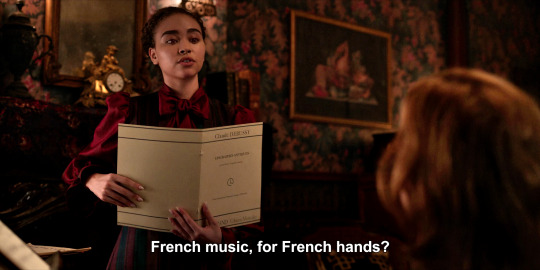
Six épigraphes antiques
Claude Debussy, 1914
This suite was originally composed to be played as a duet, but Debussy re-transcribed it as a solo piece the next year.

The Garden of Earthly Delights
Hieronymus Bosch, 1503–1515
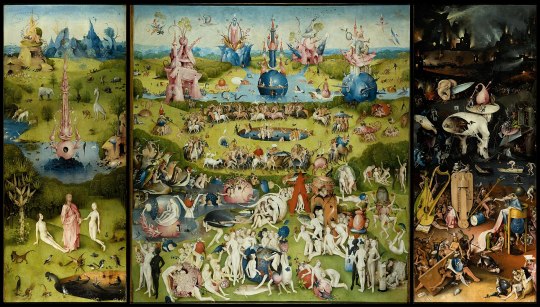
Original sin is the theme of Lestat's Mardi Gras ball. The triptych shows that sin "starts in Paradise or Eden on the left panel, with Adam and Eve, and is punished in Hell in the right panel. The centre panel depicts a Paradise that deceives the senses, a false Paradise given over to the sin of lust. This deception is encouraged by the fact that the centre panel is shown as a continuation of Eden through the use of a single, continuous landscape." [From Museo del Prado.]
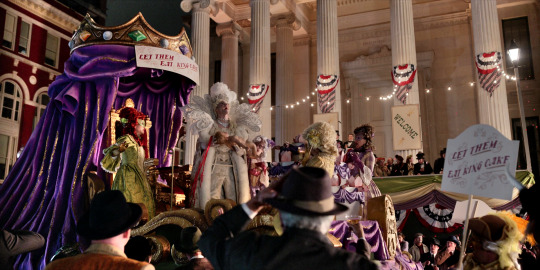
Let them eat [King] cake!
A historical reference this time: this is the traditional translation of the French phrase "Qu'ils mangent de la brioche," conventionally attributed to Marie Antoinette. The quote can be traced back to Jean-Jacques Rousseau's Confessions, published in 1765, 24 years prior to the French Revolution, when Antoinette was nine years old; and was only attributed to her decades after her death.
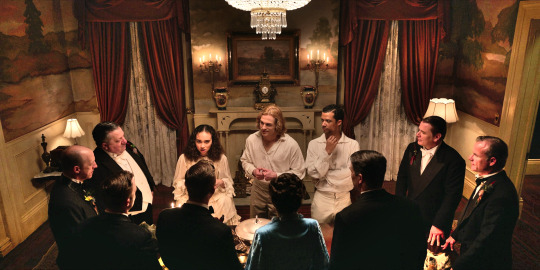
Autumn at Arkville (again!)
We first saw this painting by Alexander H. Wyant in episode 2, in the du Lac family home! It was there during the funeral too but now, almost a decade after Grace left New Orleans, we see it in Rue Royale. We wonder: was this simple prop recycling, or should we ask ourselves how and why Louis came to have that keepsake from his family?
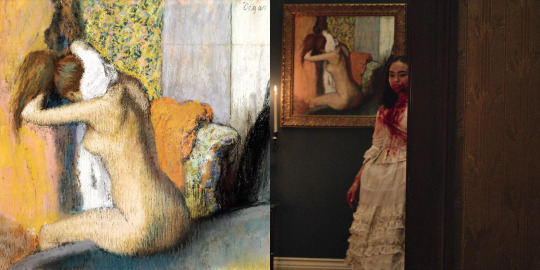
After the Bath: Woman Drying her Neck
Edgar Degas, 1898 [Identified by @nicodelenfent, here.]
This is the third Degas in Rue Royale! It's part of a series of studies of women drying after bathing, which includes charcoal sketches, and we suspect that the unidentified drawing from the hallway might be one of them.

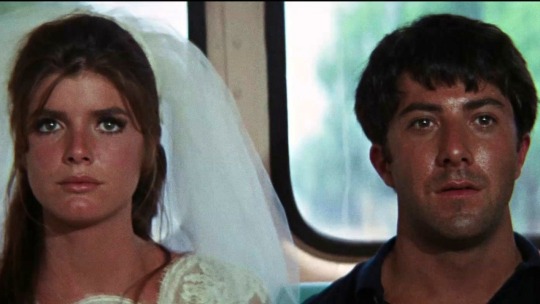
Piano Sonata No. 14 in C-sharp minor
Ludwig van Beethoven, 1801
The closing song of the season is a classic, better known as the Moonlight Sonata, but the first edition of the score was headed by the title Quasi una fantasia or "almost a fantasy" (a fantasia is a musical composition with roots in improvisation).
The Graduate
Dir. Mike Nichols, 1967
Not exactly a reference, but Jacob Anderson shared in interview with Collider that Rolin directed them to play that scene thinking of the final moments of this movie. Have you taken the chance to watch it during the hiatus?
If you spot or put a name to any other references, let us know if you'd like us to add them with credit to the post! And we rounded up all the unidentified pieces in this post, in case you want to take a look and see if anything feels familiar!
We're super close to the second season, and we can't wait! Of course, we'll keep watching with an eye out for interesting references, and it's always easier to find them if we're working together. So, if you spot any interesting art pieces and other references in the second season, make sure to share with the class in the tag #vampterview, and @ us or use the tag #art of the episode if you'd like us to reblog your post into our dedicated tag for these references.
And don't forget to get your very own bingo card for the upcoming predictions bingo, here!
#louis de pointe du lac#the vampire claudia#claudia iwtv#the titular vampire#spark in the dark#daniel molloy#lestat de lioncourt#vampterview#interview with the vampire#iwtv#amc interview with the vampire#interview with the vampire amc#amc iwtv#iwtv amc#IWTVfanevents#rewind the tape#analysis and meta#art of the episode#the thing lay still
33 notes
·
View notes
Text
IWTV S2 OST's appearances in the show
So, here is the list of the tracks on the IWTV S2 OST album and when they appear in the show so far. Gonna redo it with the scenes after the season ends, so this is all just episode numbers.
For S1 OST, the list is already available on Wikipedia
-- : hasn't been featured yet
Disk 1
1. Imagine E08
2. She Could E08
3. The Whole E08
4. Paris Sucks E09
5. Who Are E09
6. They Invited E09
7. Armand For You E09
8. Raglan James E10
9. The Fourth Great E10
10. A Vein E10
11. I don't like E11
12. Amadeo E11
13. Abducted --
14. Take As Many --
15. Hello Francis E10
16. First Time E08
17. Idk it's a gift --
Disc 2
1. Ladies E09
2. Jardin E09
3. Come to Me Again E10
4. Annika E09
5. Le Bucheron E10: TdV in Armand's retelling
6. Flirty Salesman ???
7. Woodcutter E09
8. Five Great Laws E10
9. Baby Lu E11
10. Je N'Aime E11
11. For Young Violinist Again -- (piano/violin ver. of E6)
12. Love Wronged --
13. In Nomine E10: Children of Darkness
14. Followed Closely E11??
15. Vien A Moi S1 Recap
16. Come to Me Rue Royale E7
20 notes
·
View notes
Text
#vcficfriday 🦇
Isaiah 1:15-18 (32364 words) by @fofoqueirah
Rating: Explicit Relationships: Armand/Lestat de Lioncourt/Marius de Romanus, Armand/Lestat de Lioncourt, Armand/Marius de Romanus, Lestat de Lioncourt/Marius de Romanus Summary: Suddenly, I hate his jealousy. I hate it! He is one of God's angelic cherubs when he smiles at me, but his eyes hold fury because I am in his Maker's arms. Wasn't Marius at the centre of our early conflict? Wasn't his longing for Marius why he spared me long enough for me to break his world, then shatter his heart when Marius came for me and not for him?
I am not ready to discuss the many thorns in our relationship. I dread bringing up Nicolas, his coven or Claudia. I can't; I am not ready myself. But I can debate Marius, and we could at least fix that grief.
Is there a way to kill what poison seeps from his heart when he thinks of me and Marius?
Would mending their relationship impact ours?
a.k.a. the one in which Lestat's attempts to fix his and Armand's ongoing resentment, ends up fixing Armand and Marius' convoluted relationship, mending his relationship with both while he's at it.
OKAY LISTEN - this is the Marius/Armand/Lestat fic I've been waiting for my whole life. The drama! The BAGGAGE!! The Daddy Issues™️!!! There's other characters and relationships woven in even though the trio is the focus and Fofo just juggles it all so well, I'm so excited for the other 14 CHAPTERS TO COME. 🥹
Lestat's Son (1673 words) @calipsan
Rating: Mature Relationships: Lestat de Lioncourt/Original Female Character(s) Summary: Giselle is a married woman living in the village near Chateau de Lioncourt. She finally gets the courage to ask a young mortal Lestat to her bed. The story is from her POV, but it is mainly an exploration of what Lestat might have been getting up to with the ladies of the village.
Honestly, the idea of Lestat having human descendants HAUNTS me and I'm so excited to see a fic finally tackling that big fat "What If?" in Lestat's mortal life!!! I love having it from a woman's POV too, something we definitely don't see a lot of in VC fic! 🙏🏼
Touched and laughing, father and daughter (201 words) by @butchybats
Rating: General Audiences Relationships: Claudia & Lestat de Lioncourt Summary: Louis is interrupted while reading and goes to find Lestat playing with Claudia.
What if I cried though, what then? Such a perfect little slice of Rue Royale era fluff, ft. Lestat being a better dad to Claudia than his dad ever was to him!!!! 🤧🤧🤧
*and if you're wondering what exactly #vcficfriday is, please feel free to check it out here! 🥹
#will i ever have a consistent format for my vcficfridays? it's unlikely#anyway pls don't forget to leave some love in the comments if you check these out!!! happy friday babes!! 🥹💖#the vampire chronicles#vc#armand/lestat/marius#armand/marius#armand/lestat#lestat/marius#lestat de lioncourt#armand#marius de romanus#claudia#louis de pointe du lac#vcficfriday#vc fic#fic recs
26 notes
·
View notes
Text
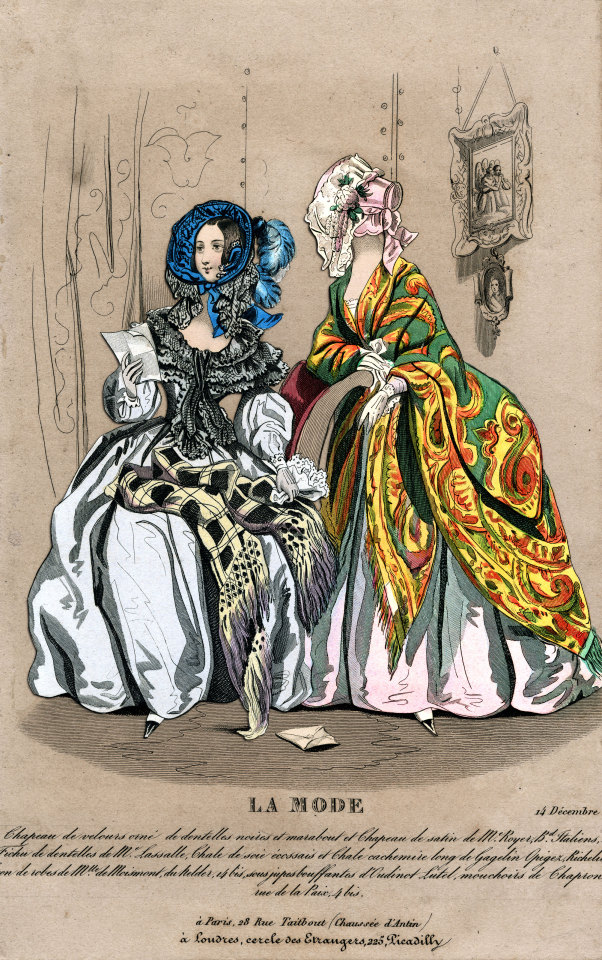
La Mode, 14 décembre 1839, Paris. Chapeau de velours orné de dentelles noires et marabout. Chapeau de satin. Fichu de dentelles. Chale de soie écossais et chale cachemire long. Digital Collections of the Los Angeles Public Library
Chapeaux de Me. Royer, Bd. Italiens. Fichu de Me. Lassalle. Chale de Gagelin Opigez, Richelieu. Robes de Mlle. de Moismont, du Helder, 14 bis., sous jupes bouffantes d'Oudinot Lutel. Mouchoirs de Chapron, rue de la Paix, 4 bis.
Left- Wearing a royal blue parasol with blue plumes. Also wearing a white bodice with puffed sleeves and black fichu at neckline. Has a yellow and purple scarf on lap. Right- Pink bonnet with white lappet. Wearing a pink bodice with a yellow, green, and orange shawl over it.
#La Mode#19th century#1830s#1839#on this day#December 14#periodical#fashion#fashion plate#color#description#lapl#dress#shawl#fichu
22 notes
·
View notes
Note
3,14, or 15 for the ship ask game👁️👁️💅
u didnt give me a subsection for them so im choosing my faves i hope thats okay 👉👈
ANSWERING THESE SHIP ASKS!!
3. domestic life // what is their wedding like? who attends?
ruetash wedding has three parts:
there's a small ceremony, just between them & their gods. then there's the public ceremony - patriars are invited, the common folk celebrate, its a big deal. then, depending on if rue has rejected bhaal or not, there's the final ceremony where she kills them both on the altar to bhaal :)
it's big and flashy and expensive to cover up some arms deals gortash has been doing that people are threatening to uncover :)
14. general // what are some songs that apply to their relationship, in-universe or otherwise?
i have a whole playlist for rue & gortash and also rue & gale if people are super curious
rue & gortash:
tear you apart - she wants revenge
i'm your man - mitski
you can be so cruel - royal blood
rule #34 - fish in a birdcage
horrible people deserve horrible love songs. nothing about them is nice and fun.
rue & gale
killer - phoebe bridgers
we're in love - boygenius
so american - olivia rodrigo
wild blue yonder - the amazing devil
these guys? sweet and nice and loving of each other in kind ways. theyve both gone through shit and find comfort in each other and its really nice!!!
15. love // what gifts do they typically give each other?
rue gives gortash really oddly specific gifts. he'll mention how he needs a certain thing and it's been a pain to get a hold of and a few days later it turns up on his desk. also body parts, mainly as proof of kills.
gortash buys her anything she wants. often gifts her expensive jewellery and clothes (only for them to be coated in blood a tenday later). lots of weapons, too. its not like he's trying to build her in his own image but she looks so nice in black and gold holding weapons he's custom made for her <3
6 notes
·
View notes
Text
20 questions for fic writers
Tagged by @quensty (thank you for the excuse to procrastinate, this was so fun!! 💕)
✨ how many works do you have on ao3?
39!
✨ what's your total ao3 word count?
535,100. But that is counting House so the real count would be a little lower. But that’s still a frightening amount of words.
✨ what fandoms do u write for?
Just Interview with the Vampire 2022 💕
✨ what are your top 5 fics by kudos?
Is this too much?, Part of Your World, I can’t help that I need it all, At Home in Rue Royale, and I’ll chew you up and I’ll spit you out.
✨ do you respond to comments? why or why not?
I don’t at the moment, I get overwhelmed and I don’t know how to respond but I treasure them and read them over and over
✨ what is the fic you wrote with the angstiest ending?
Ostentatio Vulnerum, aka Claudia isn’t there in episode 6 when Lestat tries to give Louis the car. It ends with Louis taking Lestat back and it’s very clear that Louis is not well and that’s not a good decision.
✨ what's the fic you wrote with the happiest ending?
Staring at the ceiling with you ends with Jesse Reeves and Merrick Mayfair murdering David Talbot together and escaping into the night 💕
Also Charlie living and becoming a vampire with Claudia in Charlie.
✨ do you get hate on fics?
Nope, but I’ve also had my comments set to registered users only ever since the first troll fic dropped ✌🏻
✨ do you write smut? if so, what kind?
Yes, and this is such a funny question- bloody and tender I guess? That’s probably a good way to sum it up.
✨ do you write crossovers? what's the craziest one you've written?
Haven’t written any crossovers yet! Although have the beginning pieces of a severance x iwtv crossover written.
✨ have you ever had a fic stolen?
Not to my knowledge!
✨ have you ever had a fic translated?
Yes! ITTM-verse has been translated into Polish
✨ have you ever co-written a fic before!
I have a collab oneshot wip that’s been in the works since idk March? May? We’ll get it done eventually. Keen to do more co-written pieces in the future.
There’s also House, which wasn’t co-written exactly (chapters were written by individual authors) but that was a really fun collab project.
✨ what's your all-time favorite ship?
You’re going to force me to choose between leslou, danlou, and loumand? 🥺
Outside IWTV, Frodo x Sam, Garashir, Spirk, and Korrasami.
✨ what's a wip you want to finish but doubt you ever will?
I plan to finish all my wips! That being said, Made Myself Mythical only has a vague endpoint in mind and might be something added to indefinitely depending on how long it takes me to get there.
✨ what are your writing strengths?
I really don’t know! That’s so hard to gauge!
✨ what are your writing weaknesses?
Description! I feel like I’ve gotten better but I’m not much of a visual writer/reader so it’s very hard to tell if I’m over or underdoing description at times.
✨ thoughts on writing dialogue in another language in fic?
I like to include a little here and there!
✨ first fandom you wrote for?
Harry Potter on fanfiction.net, I probably would have been 13 or 14? Then I didn’t write any more fanfiction until this year
✨ favorite fic you've written?
Either Rumpelstiltskin or Part of Your World!
I wrote Rumpelstiltskin in practically a fever over a three-day weekend. I love it, there’s the humour of Louis not knowing he’s a vampire and what the reader knows vs what Louis knows. You’ve got fairytale elements, mind gift shenanigans, loumand intricate rituals, the growing sexual tension and build up and it’s just so much fun.
And Part of Your World is my baby, I was going through a really hard time when I wrote it and it was a little sanctuary away from the stress and anxiety of everything else going on. I love the little world of it, I love Louis’s character journey, and I’m so happy with how it turned out 💕
✨ Tagging
Tagging @iwtvdramacd18 @vampdf @gayvampiredivorce and @shewhomustbecalledking and anyone else that wants to do it!
9 notes
·
View notes
Text
AAAAAAAAAAAAAAAAAAAAAAAAA
I want to adress this concept in a deep way BUT 1) I have literally no time to waste and 2) I don't want to write right now, specially in english. My hsnds are so fucking cold and have been acting numb since the beggining of the day. But whatever. The topic is:
Irrational embellishments of a City.
Look, the group as we know it of the surrealist artists (Andre Breton + Gang) reported multiples experiments surrounding the possibilities of irrational knowledge. What would the mind express when there is no rational or concious effort that could change its outcome? Dreams were a fucking incredible area of studies for the surrealism group because it was the purest expression of irrational knowledge. Other techniques revolving around speed: Giving an answer or writing ideas as fast as you could was an accesible way to obtain information not contaminated by logical or rational thought.
NOW one of those games/experiments was giving answers to questions in that exact way. Sometime around objects, dates, etc. The one that I want to bring back to table is On certain possibilities for the irrational embellishments of a City, where they suggested changes and renovations for the monuments of Paris: The Arch of Triumph, the Justice Palace, the statue of Joan D'Arc, the Eiffel Tower, etc.
(REMIND ME TO ADD REFERENCES ABOUT THE WRITTEN REPORT OF THE GAME/EXPERIMENT)
Instructions: Every participant must answer the question regarding the architecture/urbanist changes to do in a certain monument. The players were Andre Breton, Paul Eluard, Arthur Harfaux, Maurice Henry, Benjamin Peret, Tristan Tzara, George Wenstein.
Doit-on conserver, déplacer, modifier, transformer ou supprimer : – 1. L’arc de Triomphe – 2. L’obélisque – 3. La Tour Eiffel – 4. La Tour Saint-Jacques – 5. La statue de Chappe – 6. La statue de Gambetta – 7. La statue de Jeanne-d’Arc (rue de Rivoli ) – 8. Paris pendant la guerre – 9. La Défense de Paris en 1870 – 10. La République (place de la République) – 11. La colonne Vendôme – 12. Le Sacré-Cœur – 13. Le Trocadéro – 14. Le Chevalier de la Barre – 15. Le Lion de Belfort – 16. L’Opéra – 17. Les Invalides – 18. Le Palais de Justice – 19. La Sainte-Chapelle – 20. Le Chabanais – 21. Notre-Dame – 22. La Nationale – 23. La statue de Panhard – 24. La statue d’Alfred de Musset – 25. La statue de Clémenceau – 26. Le Panthéon – 27. La statue d’Henri IV – 28. La statue de Victor Hugo (Palais-Royal) – 29. La statue de Louis XIV – 30. La gare de l’Est- – 31. La statue de Camille Desmoulins ?
(To concerve, displace, modify, transform or suppress)
THE FUCKING POINT: Is that the City is a maleable piece of shit. The city is the face of a society and a culture. The monuments and the streets can be read like lines in a hand, scars, moles.
The city shapes our undertanding of it, and we are the ones who shape it (usually). NOW, what happens when our monuments and buildings are changed? Think about protests and riots. Buildings in fire or demolished according to the way they represent a philosophy and philosophies are changed.
BUT BUT BUT BUT BUT, what happens when this change is irrational? What happens when the way we change the city is absurd, is nonsensical, is an anomaly?
Paul Éluard suggested "lay it (the Arch of Triumph) on its side and transform it into the most beautiful public urinal in France." Andre Breton suggested about Notre Dame cathedral: Replacing the towers with “immense oil and vinegar cruet, one bottle filled with blood, the other with sperm" and the cathedral itself into a “school for the sexual education of virgins.” He also suggested about the Tour Saint-Jacques (below) to demolish the surrounding houses and then prohibiting all access under penalty of death for one hundred years.
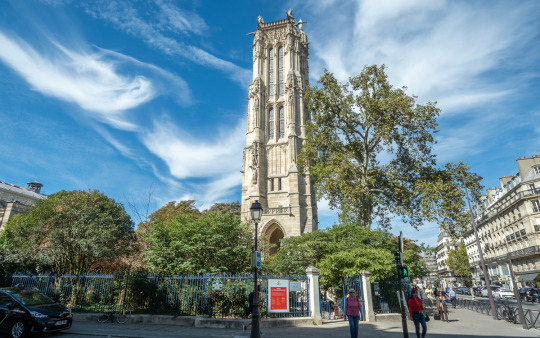
DO YOU THE POINT I'M TRYING GO MAKE HERE???
BUILDINGS ARE NOT INMUTABLE AS THOUGHTS. THEY CAN BE DESTROYED, THEY CAN BE TWISTED. We feel the oppresive and eternal presence of our monuments and towers, buildings, brindges, churches. But they can de changed and bended.
Let's make the Capitol a massive statue of balloons, the Palace Justice in Mexico a communitary pool. Let the Independe Angel statue in Mexico no longer be a roundabout, and allow the cars to go across it i any direction and take down the statue and run over it.

Let Nonsense be the apocaliptic monster that eats politics and religions, and faith and fear and rational blocks of concrete. Let it rot the chains and contaminate the walls, fuck the statues and eat the streets. Let architecture grow legs like moho and eoplod the featyres than never bringa back againts the one that atre chained and nevermore let them die aqnds eat and sleep and fuck ansd never o nevrenma ahwa am iI DON ITR NOR W AN D S;LEEP.
6 notes
·
View notes
Text
Pauline Léon timeline
A timeline over the 70 year old life of Pauline Leclerc née Léon, based primarily on the article Pauline Léon, une républicaine révolutionnaire (2006) by Claude Guillon.
-
19 October 1767 — Mathurine Téholan and Pierre Paul Léon are married in the parish of Saint-Severin in Paris. Pierre Paul runs a small chocolate business on 356 rue de Grenelle. The couple settles on rue du Basq.
28 September 1768 — birth of Anne Pauline Léon, the couple’s first child. They later have four more children — Antoine Paul Louis (1772-1835), Marie Reine Antoinette, (1778), François Paul Mathurin (1779) as well as a child who’s sex and year of birth remains unknown. Pauline later describes her father as: ”a philosopher” and adds: ”If his lack of fortune did not allow him to give us a very brilliant education, at least he left us with no prejudices.”
1784 — death of Pierre Paul Léon. Pauline, aged sixteen, now starts helping her mother with keeping the chocolate business running in order to provide for the family.
14 July 1789 — Fall of the Bastille. Pauline claims to upon this event have felt ”the liveliest enthusiam, and although a woman I did not remain idle; I was seen from morning to evening animating the citizens against the artisans of tyranny, urging them to despise and brave aristocrats, barricading streets, and inciting the cowardly to leave their homes to come to the aid of the fatherland in danger.”
February 1791 — Pauline is introduced to several popular societies in Paris. She herself claims she would frequent the Cordelier Club up until 1794 (though there doesn’t seem to exist any trace of her in the debates held there), the Fraternal Society of Patriots of Both Sexes (where again, we have few documents that mention any direct activity from her part), as well as the section of Mucius Scaevola. The same month, Pauline defenestrates a bust of Lafayette “at Fréron’s”. It seems unlikey for this attack to have been aimed at the journalist Stanislas Fréron, who frequently denounced Lafayette in his l’Orateur du Peuple, but rather his mother Anne Françoise Fréron, who handled the publishing of the royalist paper L’Ami du Roi.
21 June 1791 — Pauline, her mother and their neighbor Constance Évrard are near the Palais Royal loudly protesting the king’s ”infamous treason” (his flight) when they, according to her, are ”almost assassinated by Lafayette’s mouchards” and are saved by other sans-culottes who manage to snatch them ”from the hands of these monsters” (National guardsmen)
17 July 1791 — Pauline takes part in the demonstration on the Champ-de-Mars. On the way home, she uses her fists to defend a friend against the family of a national guard. This last incident is witnessed by Constance Evrard, another sans-culotte woman and friend of Pauline, who reports it during an interrogation. This is the first conserved trace of any militant activities from Pauline.
Late February 1792 — l’Adresse individuelle à l’Assemblée nationale par des citoyennes de la capitale, a petition regarding women’s right to bear arms, is penned down. It was most likely written by Pauline herself, seeing as the first signature on the bottom of the handwritten version kept in the National Archives, as well as the only one appearing in the version printed by order of the Assembly, is “fille Léon.” After Pauline’s name about 310 more follow, including that of her mother and many other daughter-mother couples. The petition is first read out before the Society of Patriots of Both Sexes, which, under the presidency of Tallien, orders its printing and distribution.
March 9 1792 — the Patriotic Society of the Luxembourg section sends a delegation to the Fraternal Society of Patriots of Both Sexes to request affiliation. The latter club grants the request and appoints five auditors to attend the former’s next meeting, among which are three women: Pauline Léon, Constance Evrard and Marie-Charlotte Hardon. Pauline will actively participate in the recruitment of members for the Patriotic Society, personally presenting or supporting at least seven candidates between October 1792 and September 1793
June 1792 — Pauline, along with many other men and women, signs Pétition individuelle au corps législatif pour lui demander la punition de tous les conspirateurs that calls for ”a quick vengeance” against monarchist ministers.
10 August 1792 — Pauline takes part in the Insurrection of August 10. She describes her activities in the following way: "On August 10, 1792, after spending part of the night in the Fontaine-de-Grenelle section, I joined the next day, armed with a pike, the ranks of the citizens of this section to go and fight the tyrant and his satellites. It was only at the request of almost all the patriots that I consented to give up my weapon to a sans-culotte; I gave it to him, however, only on the condition that he would use it well.”
December 1792 — Pauline, together with 3 other women and 88 men, signs the Adresse au peuple par la Société patriotique de la section du Luxembourg which demands the death of the king and pronounces threats against eventual monarchist deputies.
2 February 1793 — During a session at the Fraternal Society of Patriots of Both Sexes, Pauline is welcomed as mandated by the Defenders of the Republic of the 84 departments. At the same session, Pauline’s future husband Théophile Leclerc (1771-1820) is charged with writing a petition against commodity money. This is the first known meeting between the two.
3 February 1793 — during the session at The Fraternal Society of Patriots of Both Sexes, ”Citoyenne Léon” takes the floor to continue a denounciation against Dumouriez that Hébert has just made. Le Créole patriote reports that ”she thinks, like him, that [Dumouriez] is nothing more than an intrigant; she accuses him of several things, notably the persecution he inflicted on two patriotic battalions unjustly accused by him.”
10 February 1793 — Le Créole patriote reports the following regarding the session at The Fraternal Society of Patriots of Both Sexes:
Citoyenne Léon informs of an important denunciation made to the Commune and to the society of defenders of the republic, one and indivisible of the 84 departments. This denunciation, signed, states that on the 6th of the month a dinner was held at the house of Garat, minister of justice, provisionally exercising the functions of minister of interior, where Brissot, Barbaroux, Louvet and other noirs, composing the great and famous right side of the National Convention; plus, Bournonville, new minister of war. She calls on the society to monitor the latter, and asks that two of its members be sent to that of the Jacobins to communicate to them this fact, to which the most serious attention must be paid. Boussard makes the motion that the president be instructed to write to Bournonville, so that he can give the company explanations on this subject. These three proposals are adopted.
At the Jacobin Club the same day, ”a citoyenne,” in the name of the Fraternal Society of Patriots of Both Sexes, makes the following intervention: ”Citizens, I denounce to you Garat, minister of justice, who last Wednesday had thirty people to dinner, among which were Brissot, Barbaroux, Louvet and Beurnonville. The patriots do not have entry to this minister, and Brissot comes and goes there all the time.” It is very likely this speaker was Pauline.
17 February 1793 — Le Créole patriote reports that, during the session at The Fraternal Society of Patriots of Both Sexes, ”citoyenne Léon reads a denunciation from Citizen Godchaux against General Félix Wemphen. Several members believe that this denunciation is well founded, and urge the society to tear off the mask from all the intriguers.”
10 May 1793 — Pauline is a co-founder of the Society of Revolutionary and Republican Women (Société des Républicaines révolutionnaires or Société des citoyennes républicaines révolutionnaires de Paris), a club which only admits women as members and holds its meetings at the libary of the Jacobins, rue Saint-Honoré. Claire Lacombe, who often gets mentioned as another co-founder, actually doesn’t have her first attested appearance as a member of the society until June 26. Already on May 12, the club presents itself at the Jacobins, proposing to arm patriotic women between ages 18 and 50 in order to organize them against the Vendée. A week later, May 19, a delegation made up of members from both the Cordeliers and Revolutionary and Republican Women present themselves before the Jacobins yet again, asking for the arrest of all suspect people, the establishment of both revolutionary tribunals in all departments and a revolutionary sans-culotte army in every town, an act of accusation against the girondins, the extermination of “the stockbrokers, the hoarders and the selfish merchants” who are responsible for a conspiracy attempting to starve the people, that the revolutionary army of Paris be increased to 40,000 men, that land be distributed to the soldiers, as well as the send forth of the petition to the Convention. Though Pauline’s presence can be supposed for both of these occasions, we don’t have any hard evidence for it.
2 June 1793 — Pauline leads a delegation from the Society of Revolutionary and Republican Women wishing to be admitted to the Convention, carrying a request in her own handwriting. They are however quickly forgotten in the tumult caused by the Insurrection of May 31, which this day ends with 22 girondins being put under house arrest. During this same insurrection, several Revolutionary and Republican Women are arrested, and Pauline, as president of the Society, signs a warrant by which they demand the liberation of one of them, detained for having threatened three men with a knife.
June 1793 — Pauline is the author of a denounciation against the grocer Le Doux, rue du Sépulcre, accused of “bad comments,” mainly consisting of complains about the looting. We don’t know if the denounciation had any consequences.
9 July 1793 — Le Réglement de la Société des citoyennes républicaines révolutionnaires de Paris is published. The document is signed by president Rousaud and four secretaires: Potheau, Monier, Dubreuil och Pauline Léon.
July 10 1793 — Pauline goes to the Jacobin club, where she, ”in the name of the Revolutionary and Republican Women, presents a petition demanding the exclusion of nobles from all employments.”
July 20 1793 — A Délibération de la Société des Républicaines révolutionnaires, relative à l’érection d’un obélisque à la mémoire de Marat, sur la place du Carrousel, is signed by Pauline. The text is read at the Jacobins on July 26, by a deputation from the Society of Revolutionary and Republican Women.
July 31 1793 — Réglement de la Société des citoyennes républicaines révolutionnaires de Paris is published. The document is signed by the president, Rousaud, and four secretaries: Potheau, Monier, Dubreuil and Pauline Léon.
15 August 1793 — At the Jacobin club, ”citoyenne Léon, at the head of a deputation from the Society of Revolutionary and Republican Women, comes to request assimilation and correspondence for said Society. She also asks that the Jacobins contribute to the costs of the obelisk erected in Marat’s honor.”
30 October 1793 — Jean Pierre André Amar, member of the Committee of General Security, announces the dissolution of the Society of Revolutionary Women to the National Convention.
12 November 1793 — the marriage contract between Pauline Léon and Théophile Leclerc is signed. Through it, we see that the husband brings property valued at 300 livres, while the wife holds 1000 livres consisting of both money and effects. Pauline was in other words richer than Leclerc. She declares to after her marriage have returned to the chocolate making business and ”devoted myself entirely to the care of my household and given the example of conjugal love and the domestic virtues which are the basis of love of the homeland.”
March 17 1794 — Pauline joins Leclerc at La Fère (Aisne), where the latter is mobilizing.
April 3 1794 — the Leclerc couple is arrested on orders given by the Committee of General Security. They are taken to Paris and locked up in the Luxembourg prison three days later.
4 July 1794 — At the Luxembourg prison, Pauline either writes or dictates Précis de la conduite révolutionnaire de dame Pauline Léon, femme Leclerc, which is adressed to the Committee of General Security. It is from this document we learn almost all the details regarding her militant activities and private life. Unfortunately, I’ve not been able to find it published in full.
5 August 1794 — Pauline writes to ”sensible Tallien” and pleads for the cause of ”800 imprisoned people.” One day later she adresses herself to to ”the representatives” and asks them to at least consider a prompt examination of their case. Pauline claims that Leclerc and Pierre-François Réal were imprisoned for having "collected evidence against the accomplices of the tyrant Robespierre who were to have their throats slit." The following day, the two men are brought before the Committee of General Security. Réal is immediately set free, Pauline and Théophile joins him on August 22.
22 July 1804 — Pauline writes the following letter (cited in full within the article Un sans-culotte parisien en l’an XII: François Léon, frère de Pauline Léon (1982) by Michael David Sibalis) to Réal, by now one of those in charge of the general police, asking for the liberation of her younger brother François Paul Mathurin, imprisoned since three and a half months back for having written and published leaflets critical of Napoleon. Through the letter, we learn about some things that have happened in her life during the ten years since the last trace of her:
4 Thermidor [year 12] Monsieur, A month ago I presented a petition to the Grand Judge; at the same time I had the honor of writing to you, to request the release of my brother, named François Léon, imprisoned in the Bicêtre for a bad verse; I would ask for your indulgence, today I appeal to your justice; four months of such harsh detention had to atone for his fault; moreover his friend guilty of the same extravagance, since of two verses, one wrote the first and the other the second, was released; my brother is not more guilty, perhaps he is less; his delicacy did not allow him to justify himself at the expense of his friend; which certainly does not deserve punishment. Based on this, Monsieur, I believe I have the right to ask for his release; and I have the firm confidence that you will grant it to us; if you could still deign to think of his mother, who is old and more punished than him. This poor woman is exhausted trying to help and console him. She who needs help for herself, I am not talking to you about the grief her family is experiencing at the loss of my time (which is precious since it must be used to feed my son and relieve my mother), having, Monsieur, the advantage of having known you, I think you will not disdain these considerations. Salut and respect, Femme Leclerc Teacher (Instritutrice) Rue Jean Robert No. 4
François will be set free and leave Paris, the police having labeled him as a ”pronounced anarchist, difficult to correct.” In his interrogation, held May 2 1804 (it too cited in full within Un sans-culotte parisien en l’an XII…) he reveals that he is a tailor living alone on rue du Vieux Colombier N. 744 and ”very republican.” François’ accomplice Jean Sorret did in his interrogation claim that his friend was ”a pronounced jacobin, as is the rest of his family.”
October 5 1838 — death of Pauline in Bourbon-Vendée, rue de Bordeaux, one week after her seventieth birthday. She had moved there to settle with her sister Marie Reine Antoinette and her family somewhere between 1812 and 1835.
47 notes
·
View notes